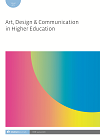
Full text loading...

This study reports on the unanticipated findings of a small-scale, evaluative research project. Further to a pilot iteration, a cohort of undergraduate art students engaged with an immersive, inclusive arts curriculum informed by critical disability studies. Students’ perceptions and attitudes about disability were recorded at the outset and conclusion of the pedagogical project, through a qualitative questionnaire. Thematic analysis was employed to surface patterns in the cohort’s responses at both points in their learning journey. While the findings evidenced the anticipated shift from individualized perspectives about disability to an increasingly social, interactional perspective, the full extent of the medicalized gaze and internalized ableism at the outset of the study was unanticipated. This realization has been influential in developing the pedagogical approach and the framing of the content taught, and has exemplified both the potential and the need to learn about disability, disablement and diversity through art education.

Article metrics loading...

Full text loading...
References


Data & Media loading...

Publication Date:
https://doi.org/10.1386/adch_00036_1 Published content will be available immediately after check-out or when it is released in case of a pre-order. Please make sure to be logged in to see all available purchase options.